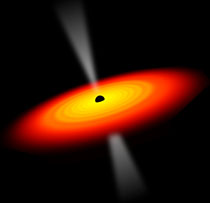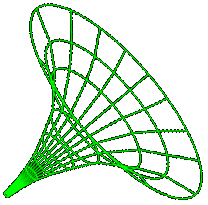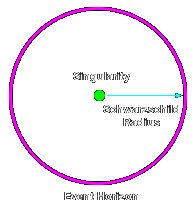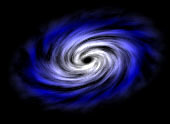

Black holes are arguably the strangest and most mysterious objects in the universe. Their bizarre properties can challenge the laws of physics and even the very nature of reality itself. To understand black holes, we must learn to think "outside the box" and use a little imagination. Black holes are formed from the cores of super massive stars and can best be described as regions of space where so much mass is concentrated that nothing, not even light, can escape the gravitational pull. It is an area where the escape velocity is greater than the speed of light. The more massive an object is, the faster you have to travel to escape its gravity. This is known as the escape velocity. Black holes are so massive that their escape velocity is faster than the speed of light. Since nothing can travel faster than light, nothing can escape the gravity of a black hole. It was Einstein's general theory of relativity that provided the first clue to understanding black holes. His theory also states that gravity affects time. The more massive an object is, the more it can slow down time. The gravity of a black hole is so great that time nearly stands still. If you were on the outside of a black hole watching a spaceship fall in, you would see the spaceship appear to slow down until it finally disappears. A common myth about black holes is that they will suck in all matter around them. This is not true. They will suck in matter within a certain distance from them, but beyond that, they act no differently than a massive star. If our Sun could become a black hole, the planets would continue to orbit around it the same as they do today.

Einstein's theory of relativity describes gravity as a curvature of space-time. The more massive the object, the greater this distortion will be. Black holes are so massive, that they distort space-time into a deep, bottomless well from which nothing can escape. Black holes are actually formed from super massive stars whose mass measures at least ten times that of our Sun. Stars burn hydrogen in a process known as fusion. This nuclear process produces pressure that pushes out from the center of the star. This pressure counteracts the force of gravity, which pulls inward. The two forces are perfectly balanced. This prevents the star from collapsing or blowing apart. When the star exhausts its supply of hydrogen fuel, this balance is upset. These massive stars will eventually end their lives in a supernova explosion. What happens after that depends on the star's mass. Most massive stars will leave behind a small core known as a white dwarf star. This core is usually surrounded by an expanding shell of gas. In a few rare cases, the mass of the star is so great that gravity will pull the star's matter in so tight it becomes a tiny, compact object known as a neutron star. But in a very few instances, there is so much mass in the star that gravity literally goes crazy. Nothing in the universe can halt the implosion. The mass of the star collapses in on itself and continues to the point where it occupies a single point in space. It literally fades out of existence. But its mass and gravity remain. It is now a black hole, one of the most unusual objects in the cosmos.

When a super massive star collapses into a black hole, it becomes so small that it no longer has any physical size. It is infinitely small and infinitely dense, yet it contains the same amount of mass as the original star. This is what is known as a singularity and it defines the center of the black hole. It is an area where the fundamental laws of physics and the very fabric of space and time seem to break down and cease to exist. The singularity is surrounded by an invisible barrier called the event horizon. The event horizon marks the outer boundary of the black hole's extreme gravitational influence. It is the point of no return. Anything that crosses the event horizon, even light, is doomed. The event horizon is the point at which the escape velocity is equal to the speed of light. The escape velocity inside the black hole is greater than the speed of light. Since nothing can travel faster than light, nothing can escape from within the event horizon. Once here, an object will soon encounter the singularity. Since the gravitational pull is increasing at such a high rate, it will be greater on the part of the object closest to the singularity. These tidal forces will cause the object to be stretched out into a long, thin string as it enters the singularity and ceases to exists in the known universe. The distance between the singularity and the event horizon is known as the Schwarzschild radius. The more massive the black hole, the larger its Schwarzschild radius will be. If the Sun were a black hole, its Schwarzschild radius would be 3 kilometers. A typical black hole with a mass 10 times that of the Sun would have a Schwarzschild radius of 30 kilometers.

Since light cannot escape from the massive beasts, they can't be seen. To search for them, we must rely on indirect evidence for their existence. One way of searching for a black hole is to look for areas of space that exhibit a large amount of mass in a small, dark space. By searching for these types of objects, astronomers have found them in two main areas: in the centers of galaxies and in binary star systems within our own galaxy. In fact, most astronomers now believe that a super massive black hole may exist in the center of our own Milky Way galaxy. Does this mean that it will eventually swallow all of the matter in the galaxy? Actually, no. The black hole has the same mass as the original star that it was formed from. As long as nothing gets too close to the event horizon, it is safe. It is likely that the billions of stars in our galaxy will continue to orbit around this giant black hole for billions of years to come. The evidence for this and other black holes can be confirmed by searching for x-rays. Astronomers believe that black holes emit strong amounts of x-rays. Many of the stars in our galaxy exist as binary star systems. Sometimes one of the two stars in a binary system becomes a black hole. When this happens, the black hole may begin to suck matter from the other star. This matter swirls around the black hole in a formation known as an acceleration disk, moving faster and faster as it nears the center. It is believed that this matter emits radiation in the form of x-rays as it enters the black hole and is crushed out of existence. Binary star systems that emit strong amounts of x-rays are good black hole candidates. Once such a system has been identified, astronomers next try to determine the mass of the star's companion. By measuring the orbital speed of the visible star, they can figure out the mass of its invisible companion. If the mass of the companion object is large enough, then it may very well be a black hole. One of the likeliest candidates today for a black hole is Cygnus X-1. It is an intense x-ray radio source located in the constellation Cygnus.
Stars | Planets | Moons | Asteroids-Comets | Nebulae | Star Clusters
Galaxies | Pulsars | Quasars | Black Holes | Dark Matter